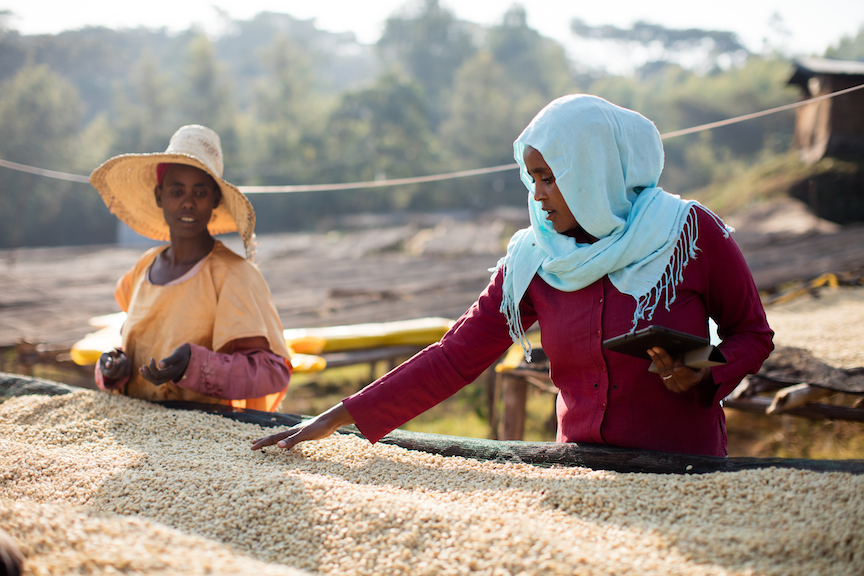
Everything You Wanted to Know About Peaberry Coffee
It’s one of the rarest types of coffee. Connoisseurs treasure it for its delicacy. And it is neither a pea nor a berry.
What is a Peaberry?
So…what is a peaberry? A peaberry is a type of coffee bean. It comes from a plant that only grew a single seed instead of the usual two.
How Peaberry Coffee Beans Grow
Coffee beans grow within fruits called cherries; when ripe, they turn a vibrant red. Most of the time, the cherry contains two seeds that grow side-by-side. These are typical coffee beans. Growing together within the fruit, they develop that shape that you’re familiar with, with a flat side and a domed side.
About 5-10% of the time, only one seed grows within the cherry, possibly due to only one ovule being pollinated. These single beans are called peaberries. (Yes, if you’re curious, it is also possible for three berries to mature in a cherry, though that is even rarer.)

Where Do Peaberry Coffee Beans Grow?
They can appear in all coffee growing regions around the world., from Brazil to Sumatra to Kenya.
Tanzania Peaberry Coffee
For many years, Tanzania’s coffee, one of its major exports, has gone to European or Asian markets; these markets prize uniformity in coffee bean size, because uniformity results in more even coffee roasting. Because peaberries are small, they were eschewed by those markets, and the exporters would sort their coffee and remove these small beans, blending them into something called ‘peaberry grade.’ That’s when they were discovered by the U.S. markets, and Tanzania Peaberry has become a type of coffee in and of itself.
Kenya Peaberry Coffee
Kenya is also known for its peaberries, likely because of their strict grading system. Kenya sorts and grades coffee differently than other origins, using a total of eight grades before roasting to determine their size. We know that bean size is important, since consistency in size reflects in consistency of roast. And Kenya also use the auction system—for over 100 years the Kenya Auction has been the ultimate meritocracy for coffee, with the top prices awarded to the most exquisite lots, sampled in cupping rooms around the world.
How Are Peaberry Coffee Beans Different from Other Coffee Beans?
Because peaberries have the cherry all to themselves, they are shorter, plumper, and rounder than their twinned brethren. Since they are sized and shaped differently from regular beans, they require different coffee roasting techniques, and so they must be sorted and separated.
How Are Peaberries Identified
All but the most practiced coffee growers can’t tell from looking whether a cherry is concealing a peaberry or a normal pair of beans. This becomes apparent only after the cherries are processed and dried. Growers use sieves, or sometimes more sophisticated machinery that sorts by weight and size, to differentiate peaberries from the rest of the beans.
Are Peaberry Beans Better Than Other Coffee Beans?
Peaberries are not intrinsically superior to other beans, just different. The same factors that influence the quality of regular coffee beans, from terroir to processing method to transportation and roasting, affect peaberries in the same way.
What Does Peaberry Coffee Taste Like?
Devotees of peaberries swear that they impart bright acidity, sweetness, and more complex flavors than their counterparts. For example, Guatemalan coffees are famous for their chocolatey notes—so a Guatemalan peaberry would be extra chcoloatey. Some theorize that the peaberries benefit from not having to share nutrients with a sibling bean during maturation and therefore have more flavor, but there is no actual evidence for this. Any difference in flavor may be a factor of the way they’re roasted, and it’s always important to keep in mind that higher quality coffee will yield higher quality peaberries.
How Are Peaberry Coffee Beans Roasted?
Since they are rounder, they roll more easily in the roaster, making heat transfer more efficient. On the one hand, this means that the first crack can come earlier and at a lower temperature than with regular beans, but since they are plumper, it can take longer for heat to penetrate to the center of the bean. Great attention to detail is required so as not to scorch the peaberries.
Does Peaberry Coffee Have More Caffeine?
Because the single peaberry bean gets all the nutrients of the coffee cherry, some believe it must have more caffeine in it. This is one of the ways that the amount of caffeine in a cup of coffee can vary.
Why Is Peaberry Coffee So Expensive?
Since peaberries occur only in about 5-10% of coffee cherries, they are relatively rare. They must also be sorted and separated, which is usually done by hand. Add to that the mystique and perception that they have a uniquely complex flavor, and peaberries have a cachet that puts them in a class of their own. For these reasons, coffee connoisseurs are happy to pay a premium for these special beans.


